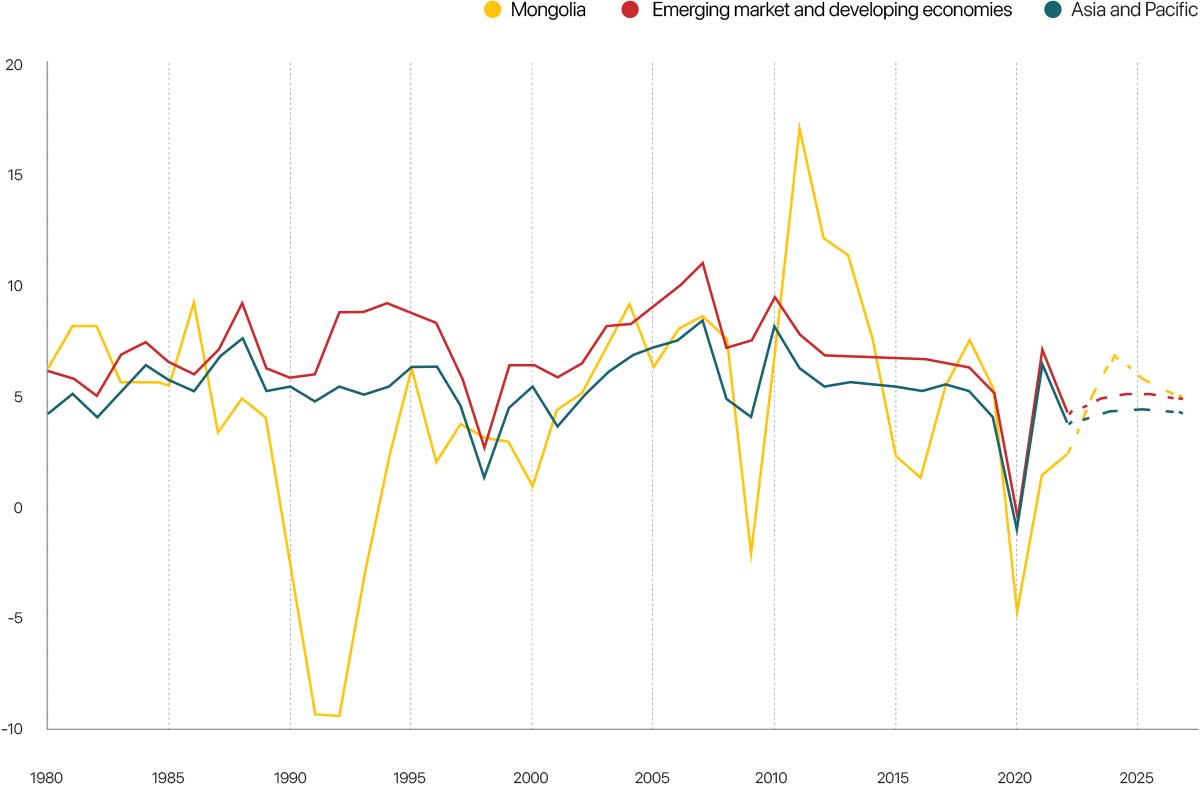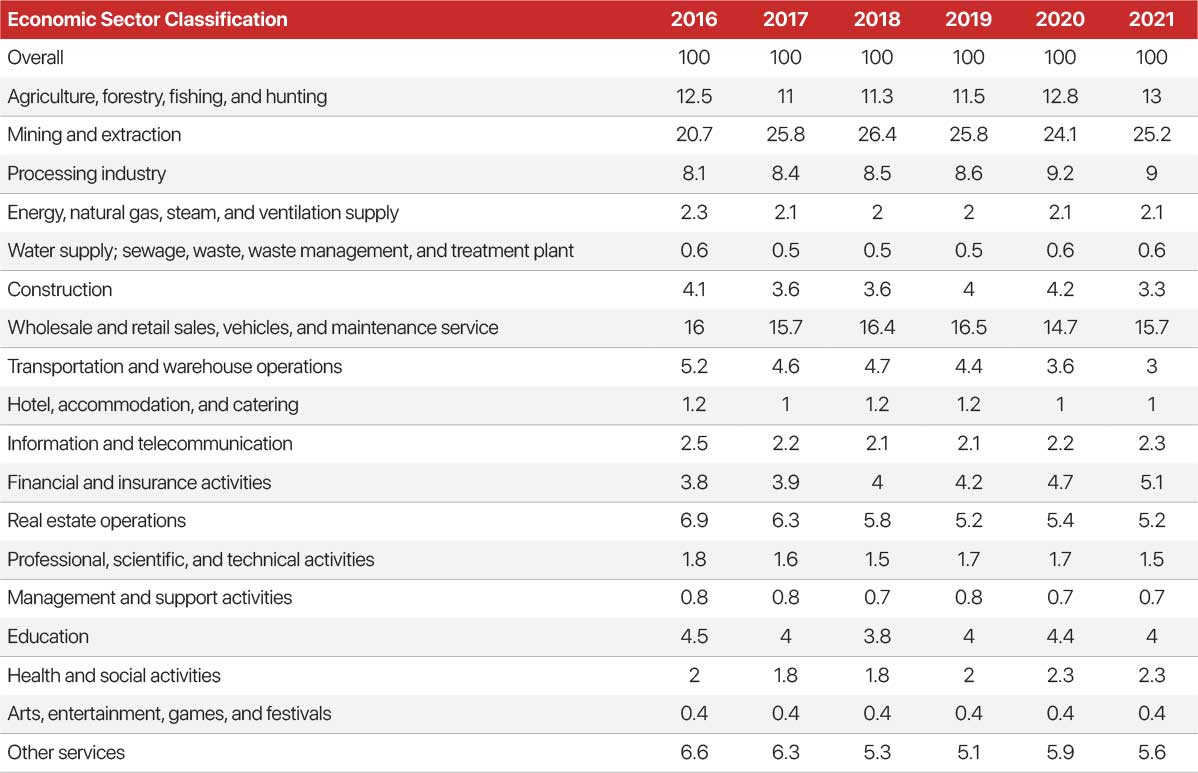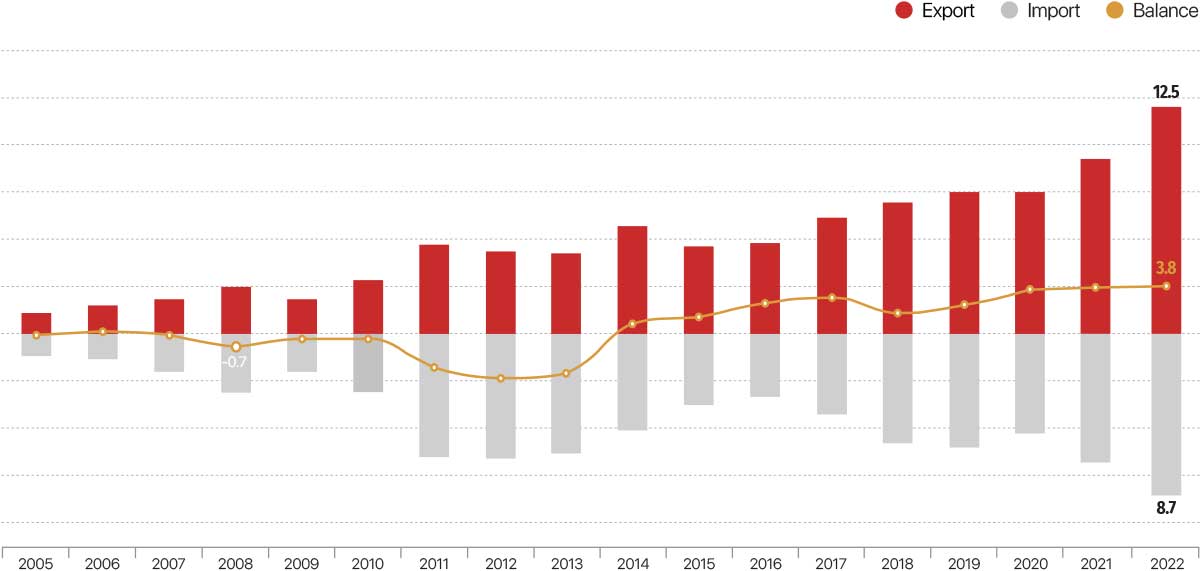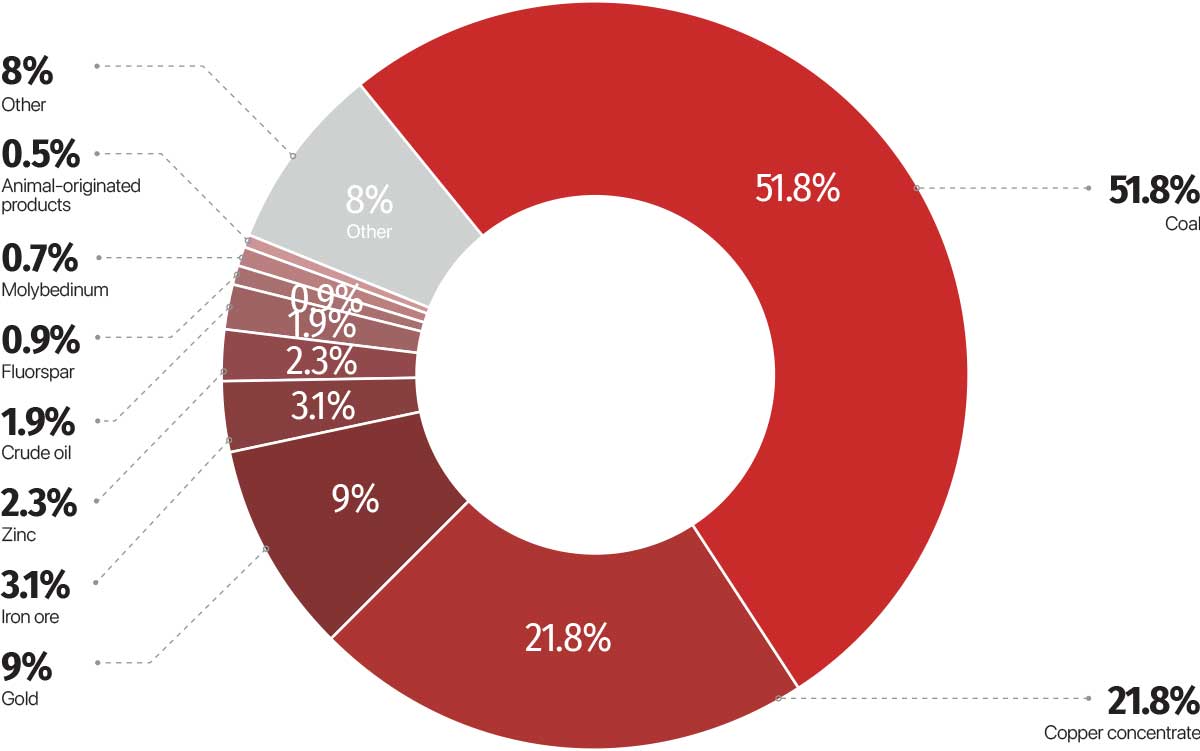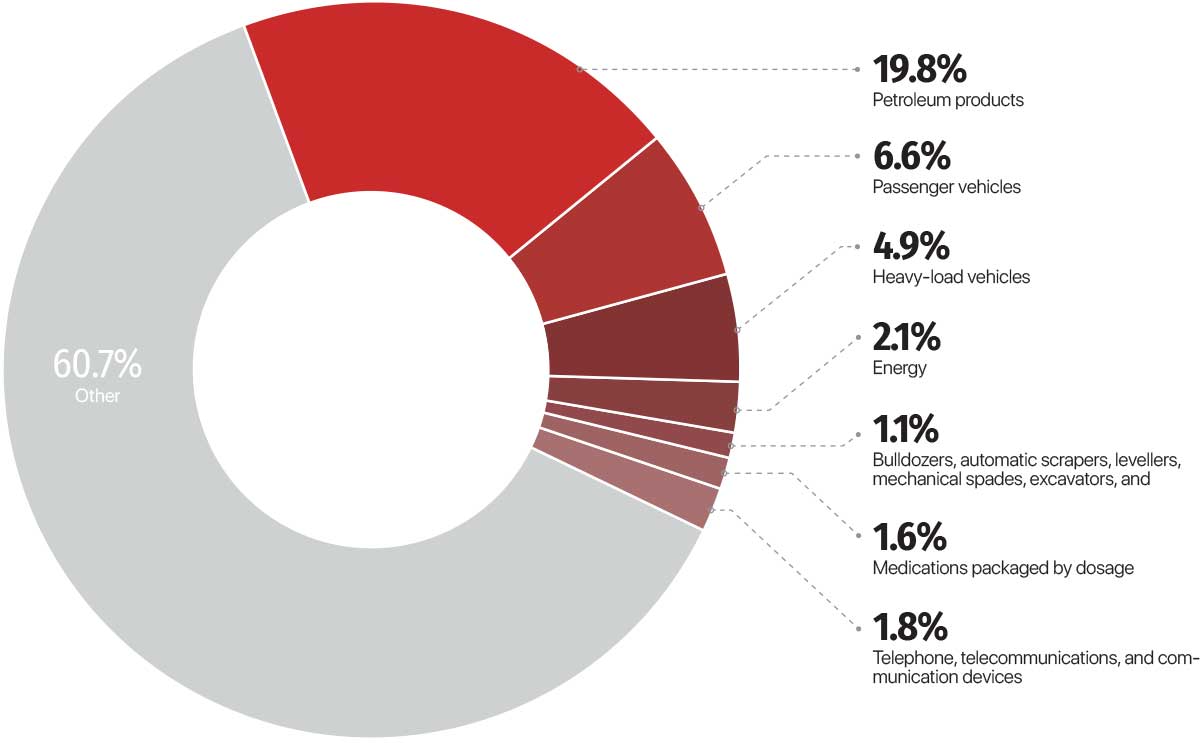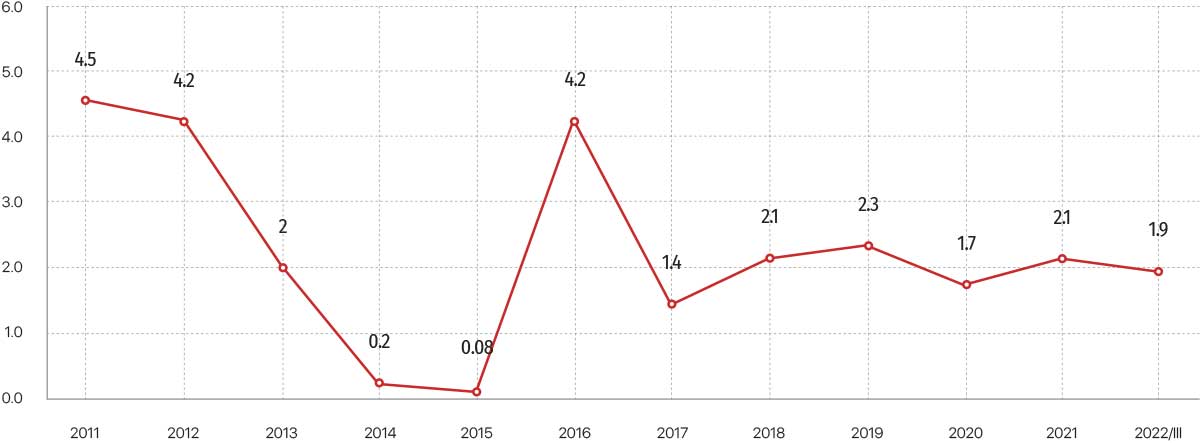KEY ECONOMIC INDICATORS
GDP:
GDP growth rate:
GDP per capita:
Unemployment rate:
Central bank interest rate:
Inflation:
Foreign currency reserves:
US $3.4m
Foreign exchange rate:
US $1 = ₮3,444
FDI:
Average wage:
₮1.6m (US$457)
Trade partners:
160 countries
Mongolia is currently experiencing an important milestone in its development. Over the past 30 years, the economy of Mongolia has grown rapidly, mostly thanks to its mining production. However, despite the fact that its GDP has grown fivefold, economic growth is volatile and social inequality is high. Consequently, Mongolia intends to stabilize its economic growth path by boosting overseas access. The country’s long-term development policy which was adopted earlier 2021 aims to increase GDP threefold to $30bn by 2030.
The key pillar of this growth trajectory would be of course the mining industry and the policy document sets out a course for the mining industry to grow from a current rate of 24% of GDP to a rate of 34% of GDP by 2030. This gives Mongolian policymakers the need to pay special attention to the mining industry.
According to Fitch Solutions, Mongolian real GDP is estimated to grow by 4.5% in 2023.
The reopening of Mainland China’s economy has brightened Mongolia’s export outlook, alongside broader signs that external risks are easing, while a resumption of key mining activities will help support domestic output.
The major positive development for Mongolia in recent months is Mainland China’s shift away from its zero-Covid policy. Mongolia’s goods shipments to China alone historically account for over 80.0% of total exports, and for more than 40.0% of GDP. While pandemic-related weakness in China held back Mongolia’s exports in 2022, this constraint is now set to ease. Broader external risks are also starting to ease. For example, the sharp drop in Mongolia’s foreign reserves bottomed out in recent months, having risen from the trough of $2.8bn in October 2022 to the most recent figure of $3.4bn in December. The ratio of imports to foreign reserves has been stabilising too, albeit at a low level. Though, high inflation and aggressive monetary policy tightening are still considered high risks to the economy.
Real GDP Growth (Annual Percentage)
Source: International Monetary Fund, October 2022
As an exporter of minerals, Mongolia is highly vulnerable to price fluctuations of commodities, therefore, the current turmoil induced by the Covid-19 pandemic poses a risk to the economic stability and exposes its weakness of unsustainable growth. On top of this, the lack of resource management exacerbates its vulnerability as suggested by Fitch Solutions.
GDP breakdown by industry
GDP (annual %)
GDP per capita ($)
Foreign trade
In 2022, Mongolia traded with 160 countries worldwide and total trade turnover reacher $21.2 billion, of which $12.5 billion were exports, and $8.7 billion were imports. Total foreign trade turnover increased by 32% over the previous year, mainly due to the increase of mineral exports. The foreign trade balance was in surplus of $3.8 billion in 2022 and increased by 60% compared to the prevous year. Trade with China reached $13.7 billion, which accounts 64.3% of the total trade turnover.
Import-export trade balance, by year ($bn)
- Mongolia has been a member of the World Trade Organization (WTO) since 1997 and applies MFN tariffs for WTO member countries.
- In 2015, Mongolia and Japan signed the Japan-Mongolia Economic Partnership Agreement (EPA) and entered into force on 7 June 2016. The EPA contains 11 chapters covering areas of trade in goods and services, customs procedures and trade facilitation, electronic commerce, investment protection, movement of persons, competition, protection of intellectual property, dispute resolution, and the improvement of the overall business environment.
- In 2016, Mongolia and Canada signed a Foreign Investment Promotion and Protection Agreement (FIPA) and entered into force on March 7, 2017.
- In 2017, Mongolia and the United States signed a Bilateral Investment Treaty (BIT), known as the USA - Mongolia Agreement on Transparency in Matters Related to International Trade and Investment.
- The Mongolia Third Neighbor Trade Act has been submitted to the United States House of Representatives. This bill is expected to exempt Mongolian textiles and knitted products from taxes in the US market.
- Mongolia has also joined the Asia-Pacific Trade Agreement, which took effect on January 1, 2021. Under the agreement, a total of 2,323 Mongolian products will enjoy 10-50% tariff incentives. In addition, 187 products will be completely exempt from tariffs when exporting to the Chinese market.
- At the time of writing, Mongolia has concluded tax treaties with 29 countries to avoid double taxation.
Foreign direct investment (FDI)
The Government of Mongolia has been paying special attention to maintaining a clear and long-term investment environment.
During the Economy Amid the Pandemic: Public-Private Investor Meeting held in August 2021, Oyun-Erdene Luvsannamsrai, Prime Minister of Mongolia, expressed his apology on behalf of the Government for the uncertainties relating to foreign investment and said that “the government will continue to take a very responsible approach to investment.”
Foreign direct investment (FDI) has been steadily increasing in Mongolia in recent years, but in 2021 it reached a level of $1.3bn, 50% decrease from 2020, largely due to the Covid-19 pandemic. The mining sector, particularly the Oyu Tolgoi project, is a major contributor to Mongolian FDI.
In the 3rd quarter of 2022, FDI reached $1.9bn, with half of it directly linked to the Oyu Tolgoi project. Over the past 30 years, FDI in Mongolia has totaled $35.7bn.
FDI inflow in Mongolia (in billion $)
FOREIGN DIRECT INVESTMENT STATISTICS
Credit rating
To assess the country’s credit rating, the Government of Mongolia annually references the international credit rating agencies: Fitch Ratings, Moody’s Investors Service, and S&P Global Ratings.
Mongolia’s credit rating has remained stable over the last year, facilitated by the sustained growth of the country’s economy, an expanded financing program in conjunction with the International Monetary Fund, and the stability in commodity markets, despite the Covid-era challenges.
Mongolia’s credit ratings
Mongolia’s credit ratings
The Tugrik (also known as Tögrög) is the official currency of Mongolia, with the symbol MNT. At the end of 2022, 1 US dollar was equal to 3,444.6 MNT. The value of the Tugrik against the US dollar decreased by 20% in 2022, due to factors such as inflation and the impact of Covid-19, after having remained stable for several years.
The Government of Mongolia has implemented a liberal policy in relation to foreign exchange. Consequently, the Tugrik is a fully convertible international currency.
Mongolia has a governed floating currency. In other words, the exchange rate is determined purely by the market principle of supply and demand, meaning that the central bank will only intervene occasionally in order to prevent any drastic swings in external foreign exchange markets.
Also, only MNT is used for domestic transactions under the country’s Currency Law.
Investors have the right to freely distribute their assets and income abroad, such as operating profits and dividends without any impediment. The country’s Investment Law states that such monetary capital may be converted into any foreign currency of choice and freely convertible internationally.
No government-caused delays are expected for foreign remittances.
In 2019, Mongolia was placed on the “grey list” by the Financial Action Task Force, a global money laundering and terrorist financing watchdog group. Being on this list means that there are strategic deficiencies in the country’s regimes to counter money laundering, terrorist financing, and proliferation financing that need to be addressed. Within 12 months, Mongolia was off the list. This was extraordinarily quick for a developing country to undertake the reforms and actions needed to get off the grey list, particularly amid a pandemic. As a result, the correspondent banking activities were improved as the major banks of Mongolia maintain correspondent relations with foreign banks and maintain accounts in major world currencies.
CATEGORY
As an exporter of minerals, Mongolia is highly vulnerable to price fluctuations of commodities, therefore, the current turmoil induced by the Covid-19 pandemic poses a risk to the economic stability and exposes its weakness of unsustainable growth. On top of this, the lack of resource management exacerbates its vulnerability as suggested by Fitch Solutions.

